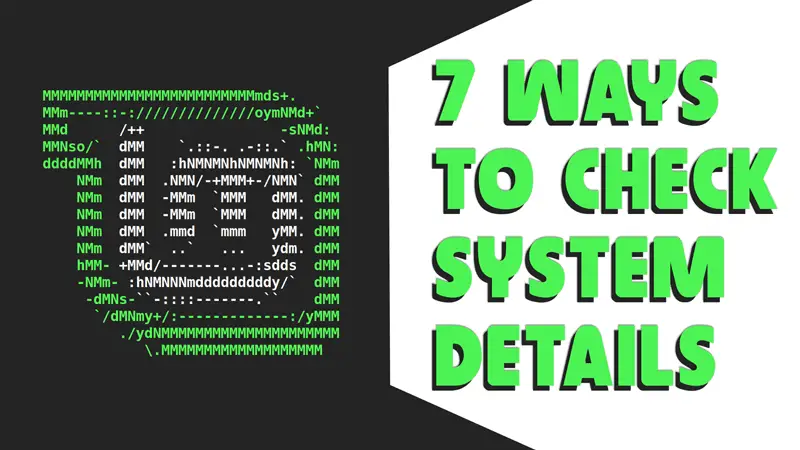Linux distributions are very amazing and interesting. We all love using these and some times we do want to know about them – Genuinely. Having that context in my little yet way more power-consuming computer – The Mind. In this article, I’m putting out the 7 different ways on how to check details about your Linux distro.
You are going to learn almost every single thing about your distro. From version editions to their code names, things that your distro uses and about any custom changes made by you.
- Distro version & it’s code name
- Info about Desktop environment
- Hardware info
- Kernel edition
- About theme & icon
- Packages & Uptime
- And a lot more!
Different ways to check the info
1. Command: “uname -a”
Using this command, you can check details like distro name, system architecture, OS type, kernel version, etc.
uname -a
Linux takshaksh 5.0.0-27-generic #28-Ubuntu SMP Tue Aug 20 19:53:07 UTC 2019 x86_64 x86_64 x86_64 GNU/Linux
2. Next Command: “lsb_release -a“
With this command, you can know distribution-specific details such as its name, distribution release version and the funky one that is its code name.
lsb_release -a
No LSB modules are available. Distributor ID: Ubuntu Description: Ubuntu 19.04 Release: 19.04 Codename: disco
3. Another Command: “hostnamectl“
This command outputs a little more information about the computer as it will show you the username, computer type, machine & boot ID, Operating system name, architecture, and kernel version which in this case is the latest :D.
hostnamectl
Static hostname: TakshakSH
Icon name: computer-desktop
Chassis: desktop
Machine ID: be3455b1301e44cab2534458221ntc77
Boot ID: c66346deda7f55f0c4feaa94414a12a7
Operating System: Ubuntu 19.04
Kernel: Linux 5.0.0-27-generic
Architecture: x86-64
4. Yet Another Command: “cat /etc/os-release“
I executed the command on the latest MX Linux 19 – Patito Feo BETA and it shows the below details. Debian is because MX Linux is based on Debian 10 (buster) and these guys didn’t even change the release metadata. But it’s okay as it’s B for BETA.
Information is pretty basic and I know you can easily understand it 😉
cat /etc/os-release
takshaksh@TakshakSH:~ $ cat /etc/os-release PRETTY_NAME="Debian GNU/Linux 10 (buster)" NAME="Debian GNU/Linux" VERSION_ID="10" VERSION="10 (buster)" VERSION_CODENAME=buster ID=debian HOME_URL="https://www.debian.org/" SUPPORT_URL="https://www.debian.org/support" BUG_REPORT_URL="https://bugs.debian.org/
5. Finally an addition utility: “screenfetch“
Screenfetch is a very little unity application that shows the distro details in a fashionable manner with an ASCII logo and everything is in color.
screenfetch -D Mint
MMMMMMMMMMMMMMMMMMMMMMMMMmds+. OS: Mint
MMm----::-://////////////oymNMd+` Kernel: x86_64 Linux 5.0.0-27-generic
MMd /++ -sNMd: Uptime: 1h 23m
MMNso/` dMM `.::-. .-::.` .hMN: Packages: 2911
ddddMMh dMM :hNMNMNhNMNMNh: `NMm Shell: bash 5.0.3
NMm dMM .NMN/-+MMM+-/NMN` dMM Resolution: 1920x1080
NMm dMM -MMm `MMM dMM. dMM DE: GNOME
NMm dMM -MMm `MMM dMM. dMM WM: GNOME Shell
NMm dMM .mmd `mmm yMM. dMM WM Theme: Adwaita
NMm dMM` ..` ... ydm. dMM GTK Theme: Mojave-dark [GTK2/3]
hMM- +MMd/-------...-:sdds dMM Icon Theme: Tela
-NMm- :hNMNNNmdddddddddy/` dMM Font: Roboto Medium, Medium 11
-dMNs-``-::::-------.`` dMM CPU: Intel core i3-8100 3.6GHz [16.8°C]
`/dMNmy+/:-------------:/yMMM GPU: Mesa DRI Intel(R) UHD Graphics 630
./ydNMMMMMMMMMMMMMMMMMMMMM RAM: 4311MiB / 7837MiB
\.MMMMMMMMMMMMMMMMMMM
This application gives away so many details about the whole computer system in a unique display. Things like OS name, kernel version, uptime, screen resolution, desktop environment, window manager, its theme, icon theme, system font, and basic hardware information with an ASCII logo which you can change as I did.
You can learn how to install it in this post: Having fun with the terminal using ASCII tools
6. Similar to screenfetch: “neofetch“
Neofetch is a little bit different but mostly it is just like screenfetch provides similar info about the system. You can install it just like you would do screenfetch.
neofetch
.-/+oossssoo+/-. takshaksh@takshaksh
`:+ssssssssssssssssss+:` -------------------
-+ssssssssssssssssssyyssss+- OS: Ubuntu 19.04 x86_64
.ossssssssssssssssssdMMMNysssso. Host: B360M GAMING HD
/ssssssssssshdmmNNmmyNMMMMhssssss/ Kernel: 5.0.0-27-generic
+ssssssssshmydMMMMMMMNddddyssssssss+ Uptime: 1 hour, 41 mins
/sssssssshNMMMyhhyyyyhmNMMMNhssssssss/ Packages: 2980 (dpkg), 5 (flatpak)
.ssssssssdMMMNhsssssssssshNMMMdssssssss. Shell: bash 5.0.3
+sssshhhyNMMNyssssssssssssyNMMMysssssss+ Resolution: 1920x1080
ossyNMMMNyMMhsssssssssssssshmmmhssssssso DE: GNOME 3.32.2
ossyNMMMNyMMhsssssssssssssshmmmhssssssso WM: GNOME Shell
+sssshhhyNMMNyssssssssssssyNMMMysssssss+ WM Theme: Adwaita
.ssssssssdMMMNhsssssssssshNMMMdssssssss. Theme: Mojave-dark [GTK2/3]
/sssssssshNMMMyhhyyyyhdNMMMNhssssssss/ Icons: Tela [GTK2/3]
+sssssssssdmydMMMMMMMMddddyssssssss+ Terminal: gnome-terminal
/ssssssssssshdmNNNNmyNMMMMhssssss/ CPU: Intel i3-8100 (4) @ 3.600GHz
.ossssssssssssssssssdMMMNysssso. GPU: Intel 8th Gen Core Processor
-+sssssssssssssssssyyyssss+- Memory: 5562MiB / 7837MiB
`:+ssssssssssssssssss+:`
.-/+oossssoo+/-.
7. Graphically knowing: “neofetch“
Finally, we are breaking the command-line and going to use the GUI aka mouse to get the information about our Linux babe.
Every single Linux distro comes with a utility application by the name Settings and in this application, you will find about section where you can get such details.


So that is it. These are the ways that you now know how to walk through. Enjoy these little informers of your Linux system.
Let me know below, what you think about it and do subscribe to the youtube channel for video tuts and I’ll get along with you soon. You keep enjoying your Linux!















